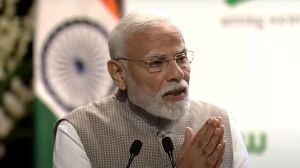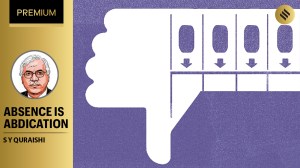Writer’s Corner: Janaki Nair says as a historian she had to get ‘estranged’ from familiar places to fully understand them
Author Janaki Nair, who has documented the history of Bengaluru and Mysuru, has one piece of advice for prospective city historians – “master Kannada”.
 Nair explained that her journey to becoming a historian started with her stint as a journalist with the Deccan Herald.
Nair explained that her journey to becoming a historian started with her stint as a journalist with the Deccan Herald.Historian, author, researcher, newspaper columnist and former professor at Jawaharlal Nehru University (JNU) – Janaki Nair has worn many hats. Some of her work, in particular, would interest the average Bangalorean, notably The Promise of the Metropolis: Bangalore’s Twentieth Century (2005) and Mysore Modern: Rethinking the Region under Princely Rule (2011).
Looking back on her connection with the city, Nair opened up in a conversation with The Indian Express, “I was born and brought up here… I have a very close relationship with the city. I must say that when you begin work as an academic or a historian, you have to estrange yourself from places you know very well. What you study can be a very different entity from what you lived and grew up in.”
“As a result, I got to know many parts of the city from a different angle. My first work was in labour history, so I began visiting areas like Binnypete and Srirampura and met very different classes of people,” she said.
Nair also spoke about the significance of Mysuru in a historical context, noting that it “was of course a princely state… In that sense, there is already a difference with Madras or Bombay Presidency. At least in terms of structure, it had more in common with Hyderabad or Kashmir than the rest of British India. Mysore was exceptional in that it had a very large peasant base, so there was no concentration of land in the hands of a few.”
While Mysore had a sluggish investment profile in the colonial period, she said, there was still a keenness to build an industrial base, especially on the part of diwans like Sir M Visvesvaraya and Sir Mirza Ismail.
Nair explained that her journey to becoming a historian started with her stint as a journalist with the Deccan Herald. That led to an advanced degree in history and her work on the history of the working class of the region.
She added, “When I moved on to writing a book on the history of the city (Bengaluru), I deliberately chose to focus on the post-Independence period rather than pre-Independence, and that itself was quite a revelation. I was then reading through the Deccan Herald archives from 1948 as a researcher. That helped put some of the city’s history in perspective. My interests were not only in the monumental heritage but also the social history of the place – questions of language, gender, work and, most importantly, the building of the city with planned and unplanned areas.”
Nair said she sometimes writes at irregular intervals throughout the day and even late at night, with some of her most productive work happening away from her home and desk.
“I had to somehow discipline myself to bring it into a framework telling the story of the city. Since then, there has been a boom in writing on Bengaluru. The IT boom attracted a lot of scholarship. There have been books on architecture, nature, work culture – we have seen a huge outpouring of popular and academic work.”
Sharing her perspectives on skills that prospective city historians ought to have, Nair said, “People who want to write about or investigate the city ought to master Kannada. Without knowing the local language and what is written in it, they would miss a great deal. Too much writing happens based on English language sources alone. There are very fine historians… For every Fazlul Hasan you have a Ba Na Sundar Rao.”












